STS-28
STS-28R was the 30th NASA Space Shuttle mission, the fourth shuttle mission dedicated to United States Department of Defense purposes, and the eighth flight of Space Shuttle Columbia. The mission launched on 8 August 1989 and traveled 2.1 million miles during 81 orbits of the Earth, before landing on runway 17 of Edwards Air Force Base, California, on 13 August. STS-28R was also Columbia's first flight since January 1986, when it had flown STS-61-C, the mission directly preceding the Challenger disaster of STS-51-L. The mission details of STS-28 are classified, but the payload is widely believed to have been the first SDS-2 communications satellite. The altitude of the mission was between 295 kilometers (183 mi) and 307 kilometers (191 mi).[1]
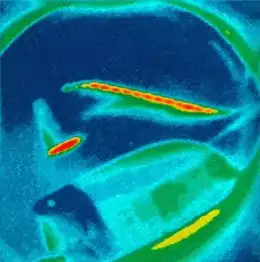 Infrared view of Columbia's left wing during reentry, photographed by the SILTS experiment | |
| Mission type | Satellite deployment |
|---|---|
| Operator | NASA |
| COSPAR ID | 1989-061A |
| SATCAT no. | 20164 |
| Mission duration | 5 days, 1 hour, 8 seconds |
| Distance travelled | 3,400,000 kilometres (2,100,000 mi) |
| Orbits completed | 81 |
| Spacecraft properties | |
| Spacecraft | Space Shuttle Columbia |
| Payload mass | 19,600 kilograms (43,200 lb) |
| Crew | |
| Crew size | 5 |
| Members | |
| Start of mission | |
| Launch date | 8 August 1989, 12:37:00 UTC |
| Launch site | Kennedy LC-39B |
| End of mission | |
| Landing date | 13 August 1989, 13:37:08 UTC |
| Landing site | Edwards Runway 17 |
| Orbital parameters | |
| Reference system | Geocentric |
| Regime | Low Earth |
| Perigee altitude | 289 kilometers (180 mi) |
| Apogee altitude | 306 kilometers (190 mi) |
| Inclination | 57.0 degrees |
| Period | 90.5 minutes |
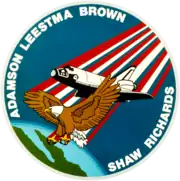
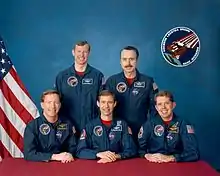 Left to right - Seated: Richards, Shaw, Leestma; Standing: Brown, Adamson | |
The mission was officially designated STS-28R as the original STS-28 designator belonged to STS-51J, the 21st Space Shuttle mission. Official documentation for that mission contained the designator STS-28 throughout. The 'R' stood for 'Recycled'. As STS-51L was designated STS-33, future flights with the STS-26 through STS-33 designators would require the 'R' in their documentation to avoid conflicts in tracking data from one mission to another.
Crew
| Position | Astronaut | |
|---|---|---|
| Commander | Brewster H. Shaw Jr. Third and last spaceflight | |
| Pilot | Richard N. Richards First spaceflight | |
| Mission Specialist 1 | James C. Adamson First spaceflight | |
| Mission Specialist 2 | David C. Leestma Second spaceflight | |
| Mission Specialist 3 | Mark N. Brown First spaceflight | |
Crew seating arrangements
| Seat[2] | Launch | Landing | 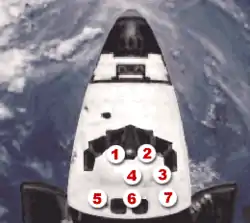 Seats 1–4 are on the Flight Deck. Seats 5–7 are on the Middeck. |
|---|---|---|---|
| S1 | Shaw | Shaw | |
| S2 | Richards | Richards | |
| S3 | Adamson | Brown | |
| S4 | Leestma | Leestma | |
| S5 | Brown | Adamson | |
Mission summary
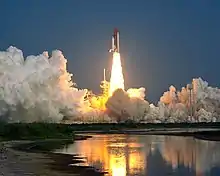
Space Shuttle Columbia (OV-102) lifted off from Pad 39-B, Launch Complex 39 at Kennedy Space Center, Florida, on 8 August 1989. The launch took place at 8:37 am EDT.
During STS-28R, Columbia deployed two satellites: USA-40[3] and USA-41.[4] Early reports speculated that STS-28's primary payload was an Advanced KH-11 photo-reconnaissance satellite. Later reports, and amateur satellite observations, suggest that USA-40 was instead a second-generation Satellite Data System relay,[5] similar to those likely launched on STS-38 and STS-53. These satellites had the same bus design as the LEASAT satellites deployed on other shuttle missions, and were likely deployed in the same fashion.
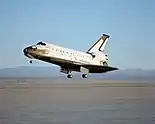
The mission marked the first flight of an 11-pound human skull, which served as the primary element of "Detailed Secondary Objective 469", also known as the In-flight Radiation Dose Distribution (IDRD) experiment. This joint NASA/DoD experiment was designed to examine the penetration of radiation into the human cranium during spaceflight. The female skull was seated in a plastic matrix, representative of tissue, and sliced into ten layers. Hundreds of thermo-luminescent dosimeters were mounted in the skull's layers to record radiation levels at multiple depths. This experiment, which also flew on STS-36 and STS-31, was located in the shuttle's mid-deck lockers on all three flights, recording radiation levels at different orbital inclinations.[6]
During the flight, the crew shut down a thruster in the reaction control system (RCS) after receiving indications of a leak. An RCS heater also malfunctioned during the flight. Post-flight analysis of STS-28 discovered unusual heating of the thermal protection system (TPS) during re-entry, caused by an early transition to turbulent plasma flow around the vehicle. A detailed report[7] identified protruding gap filler as the likely cause. This filler material was the same material that was removed during a spacewalk during STS-114, the Space Shuttle's post-Columbia disaster Return to Flight mission, in 2005.
The Shuttle Lee-side Temperature Sensing (SILTS) infrared camera package made its second flight aboard Columbia on this mission. The cylindrical pod and surrounding black tiles on the orbiter's vertical stabilizer housed an imaging system, designed to map thermodynamic conditions during reentry, on the surfaces visible from the top of the tail fin. Ironically, the camera faced the port wing of Columbia, which was breached by superheated plasma on its disastrous final flight, destroying the wing and, later, the orbiter. The SILTS system was used for only six missions before being deactivated, but the pod remained for the duration of Columbia's career.[8] Columbia's thermal protection system was also upgraded to a similar configuration as Discovery and Atlantis in between the loss of Challenger and STS-28R, with many of the white LRSI tiles replaced with felt insulation blankets in order to reduce weight and turnaround time. One other minor modification that debuted on STS-28R was the move of Columbia's name from its payload bay doors to the fuselage, allowing the orbiter to be easily recognized while in orbit.
Columbia landed at Edwards Air Force Base, California, at 9:37 am EDT on 13 August 1989, after a mission lasting 5 days and 1 hour.
Gallery
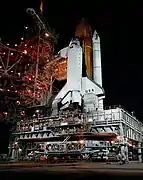 Columbia on pad 39-B.
Columbia on pad 39-B. Alaska's Malaspina Glacier imaged from orbit.
Alaska's Malaspina Glacier imaged from orbit.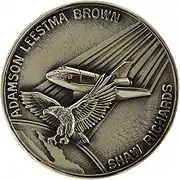 STS-28 Robbins Medallion.
STS-28 Robbins Medallion.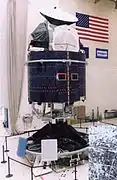 The SDS-2 satellite during pre-launch preparations.
The SDS-2 satellite during pre-launch preparations.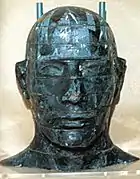 The DSO 469 human skull.
The DSO 469 human skull.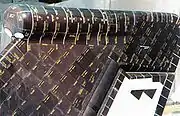 The SILTS pod.
The SILTS pod.
References
![]() This article incorporates public domain material from websites or documents of the National Aeronautics and Space Administration.
This article incorporates public domain material from websites or documents of the National Aeronautics and Space Administration.
- "STS-28 payload". Archived from the original on 4 February 2015. Retrieved 3 February 2015.
- "STS-28". Spacefacts. Retrieved 26 February 2014.
- "1989-061B". National Space Science Data Center. Retrieved 27 March 2010.
- "1989-061C". National Space Science Data Center. Retrieved 27 March 2010.
- Cassutt, Michael (August 2009). "Secret Space Shuttles". Air & Space. Retrieved 19 April 2015.
- Macknight, Nigel, Space Year 1991, p. 41 ISBN 0-87938-482-4
- "STS-28 R – Early Boundary Layer Transition" (PDF). Retrieved 27 March 2010.
- Shuttle Infrared Leeside Temperature Sensing
.jpg.webp)